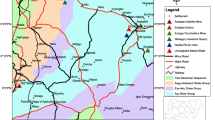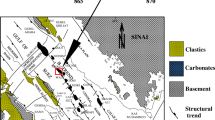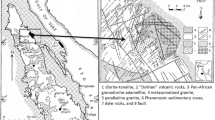Abstract
The present work utilizes in situ gamma ray spectrometric measurement data to map the surface geology of Sarıhan Granitoid and its surrounding area. The study area comprises three different lithological units, namely, Hozbirikyayla Formation (limestone and sandy limestones), Sarıhan Granitoid (consist of quartz monzodiorite, granodiorite and quartz diorite) and the Ophiolitic olistostromal melange (andesite, basalt, sandstone, gravelly sandstone). When lithological units are assessed according to the radioactivity characteristics, natural radionuclide contents (40K and radionuclides from 238U and 232Th series) of Hozbirikyayla limestones and ophiolitic melange rocks are lower than the Sarıhan pluton. The U, Th and K radionuclide contents were found to be 0.8–5.4 ppm, 10.1–33.6 ppm and 1.29–4.41% in the Sarıhan plutonic area and 0.9–5.3 ppm, 1.1–20.3 ppm and 0.04–2.71% in Horzbirikyayla formation, respectively. The element concentrations of 238U, 232Th and 40K of the Ophiolitic melange are 1.1–4.5 ppm, 1.6–25.3 ppm and 0.09–3.63%, respectively. Radioelement ratio maps are created for the studied area, because the parameters of radioelement ratios, eU/eTh, eU/K and eTh/K, reflect the radioactive characters of the rock and soil. The Hozbirikyayla Formation is characterized by the highest value of eU/eTh and lowest value of eTh/K. While the lowest eU/eTh and eU/K ratios were observed in the Sarıhan Granodiorite, the highest value of eU/K and eTh/K were obtained in the Ophiolitic olistostromal melange. By comparing these maps with the geology, it was found that the radioelement concentrations are in good agreement with the geological properties of the region. In addition to this, the radiation hazard parameters were evaluated to assess the radiation hazard for people living in this area. It has also been found that there is no significant radiologic hazard for humans and the environment in and around studied area.













Similar content being viewed by others
References
Abbady AGE (2004) Estimation of radiation hazard indices from sedimentary rocks in Upper Egypt. Appl Radiat Isot 60:111–114 (Technical note)
Abd El-Mageed IA, El-Kamel HA, Abbady A (2011) Assessment of natural and anthropogenic radioactivity levels in rocks and soils in the environments of Juban town in Yemen. Radiat Phys Chem 80:710–715
Abd El-Naby HH, Saleh GM (2003) Radioelement distributions in the Proterozoic granites and associated pegmatites of Gabal El Fereyid area, Southeastern Desert, Egypt. Appl Radiat Isot 59:289–299. https://doi.org/10.1016/j.apradiso.2003.07.002
Abu-Deif A, Abouelnaga HSO, Hassanein HIE (2007) Radioelements and Uranium Migration in Granites, El-Missikat Tunnels, Central Eastern Desert, Egypt. Earth. Sciences 18:89–115
Alharbi WR, AlZahrani JH, Abbady AGE (2011) Assessment of Radiation Hazard Indices from Granite Rocks of the Southeastern Arabian Shield, Kingdom of Saudi Arabia. Aust J Basic Appl Sci 5(6):672–682
Ali M, Shariff AA, Qamar NA, Laghar A (2012) Comparison of the Nagar Parkar (Pakistan) and Malani (India) granites with reference to uranium and thorium abundances. J Himal Earth Sci 45(1):67–76
Alnour IA, Wagiran H, Ibrahim N, Laili Z, Omar M, Hamzah S, Idi BI (2012) Natural radioactivity measurements in the granite rock of quarry sites, Johor, Malaysia. Radiat Phys Chem 81:1842–1847
Altundas S (2016) Investigation of Sarıçiçek and Sarıhan Granodiorites using in-situ Gamma-Ray Spectrometer and Magnetic Susceptibility Methods. PhD thesis (in Turkish with an English abstract), Karadeniz Technical University, Trabzon
Aslan Z (1998) Petrography, Geochemistry and Petrology of Saraycık-Sarıhan Granitoid (Bayburt) and Surrounding Rocks and Geocronology of Sanhan Granitoid. PhD thesis (in Turkish with an English abstract), Karadeniz Technical University, Trabzon
Aslan Z (2005) Petrography and Petrology of the Calc-Alkaline Sarıhan Granitoid (NE Turkey): An Example of Magma Mingling and Mixing. Turkish. J Earth Sci (Turkish J Earth Sci) 14:185–207
Aslan Z (2006) Reply to Comment on ‘Petrography and Petrology of the Calc-Alkaline Sarıhan Granitoid (NE Turkey):An Example of Magma Mingling and Mixing. Turkish. J Earth Sci (Turkish J. Earth Sci) 15:379–384
Assran SM, Abdelhadi HM, El Shayeb HM, Ashami AS, Zaeimah MA (2012) Ground Gamma-Ray Spectrometric Study and Environmental Impact for Moreid-Elsahu Area, Southwestern Sinai, Egypt. Arab J Nucl Sci Appl 45(2):240–253
Atlas B (1985) Log Interpretation Charts. Baker Hughes Inc., Houston
Aydın İ, Aydoğan MS, Oksum E, Koçak A (2006) An attempt to use aerial gamma-ray spectrometry results in petrochemical assessments of the volcanic and plutonic associations of Central Anatolia (Turkey). Geophys J Int 167:1044–1052
Aydın A, Ferre EC, Aslan Z (2007) The Magnetic Susceptibility of Granitic Rocks as a Proxy for Geochemical Composition: Example from the Saruhan Granitoids, NE Turkey. Tectonophysics 441:85–95
Beck HL, Decampo J, Gogolak C (1972) In Situ Ge (Li) and NaI (Tl) Gamma-Ray Spectrometry. Health and Safety Laboratory, New York
Beretka J, Matthew PJ (1985) Natural radioactivity of Australian building materials, industrial wastes and by-products. Health Phys 48:87–95
Bieda A, Lizurek G (2008) Natural radioactivity of rocks occurring in the contact zone of the Karkonosze massif with the Szklarska Poręba Schist belt. Acta Geodyn Geomater 5(2 (150)):225–231
Birch F (1954) Heat from radioactivity. In Nuclear Geology; Wiley: New York, 148–174
Boyle RW (1982) Geochemical prospecting for thorium and uranium deposits. In: Development Economic geology, vol 16. El Sevier, Amsterdam, p 189
Canbaz B, Çam NF, Yaprak G, Candan O (2010) Natural radioactivity (226Ra, 232Th and 40K) and assessment of radiological hazards in the Kestanbol granitoid, Turkey. Radiat Prot Dosim 141:192–198
Cermak V, Huckenholz HG, Rybach L, Schmid R (1982) Radioactive heat generation in rocks; In: Landolt-Börnstein Numerical Data and Functional Relationships in science and Technology (K.-Hellwege, Ed.), New Series; Group V. Geophysics and space research, Physical properties of rocks, supvolume b, Sprenger-verlag Berline, Heidelberg, New York, 433–481
Chan LS, Wong PW, Chen QF (2007) Abundances of radioelements (K, U, Th) in weathered igneous rocks in Hong Kong. J Geophys Eng 4:285–292
Clark SP, Peterman ZE, Heier KS (1966) Abundance of U, Th and K, In Handbook of Physical constants. Geol Soc Am 97:521–541
Darnley AG (1973) Airborne Gamma-Ray Techniques-Present and Future; Uranium Exploration Methods. International Atomic Energy Agency, Proceedings of a Panel, Vienna, 67-108
Dobrynin WM, Vendelstejn BJ, Koshevnikov DA (2004) Petrofizika. IzdatelstvoNeftiGaz, Moscow
Dortman NB (1976) Fizicheskiye svoystvagornykh porod ipoleznykh skopayemykh (petrofizika); spravochnik geofizika, IzdatNedra, Moscow, USSR, 527
Dżaluk A, Malczewski D, Żaba J, Dziurowicz M (2014) In situ measurements of natural radioactivity in selected igneous rocks of the Opava Mountain region. Contemporary Trends in. Geoscience 3:5–13
El-Arabi AM, Abbady AGE, Khalif IH (2007) Geochemistry and Radioactive Characteristics of the Garnetiferous Granite of Um Sleimat Area, Egypt. Online J Earth Sci 1:9–20
El-Taher A, Uosif MAM, Orabi AA (2007) Natural radioactivity levels and radiation hazard indices in granite from Aswan to Wadi El-Allaqi southeastern desert, Egypt. Radiat Prot Dosim 124:148–154
Eyüboğlu Y, Santosh M, Chung S-L (2011) Petrochemistry and U-Pb Zircon Ages of Adakitic Intrusions from the Pulur Massif (Eastern Pontides, NE Turkey): Implications for Slab Rollback and Ridge Subduction Associated with Cenozoic Convergent Tectonics in the Eastern Mediterranean. J Geol 119:394–417
Gaafar I, Aboelkhair H (2014) Analysis of Geological and Geophysical Datasets for Radioelement Exploration in KabAmiri Area, Central Eastern Desert, Egypt. Open Geol J 8(Suppl 1: M3):34–53
GF Instruments (2009) Gamma Surveyor User Manual. GF-Instruments, Brno
Grabianowski E (2011) How Radiation Sickness Works. HowStuffWorks.com http://www.sciencehowstuffworkscom/radiation-sickness.htm 1 March 2017
Huda A (2011) Determination of Natural Radioactivity Levels in the State of Qatar Using High-Resolution Gamma-ray Spectrometry. Ph.D. Thesis. University of Surrey, UK
IAEA (1974) Instrumentation for uranium and thorium exploration. Technical reports series No. 158, Vienna
IAEA (1989) Construction and use of calibration facilities for radiometric field equipment. In: Proceedings of IAEA technical reports series 309, International Atomic Energy Agency, Vienna
IAEA (2003) Guidelines for Radioelement Mapping Using Gamma Ray Spectrometry Data. IAEA Technical Reports Series 1363, International Atomic Energy Agency, Vienna
Ibrahim IH, Ali MA (2003) The Granitic Rocks in Wadi Ghadir Area, South Eastern Desert, Egypt and Occurrence of a Secondary Uranium Mineral, Egyptian Journal of Geology. 47:671–687
Ilbeyli N, Pearce JA, Thirlwall MF, Mitchell JG (2004) Petrogenesis of collision-related plutonics in Central Anatolia, Turkey. Lithos 72:163–182
Lundin IA, Bastani M (2007) Analysis of petrophysical properties of some granitoids in Sweden. J Appl Geophys 62:74–87
Lovborg L, Botter-Jensen L, Kirkegaard P, Christiansen EM (1979) Monitoring of Natural Soil Radioactivity with Portable Gamma-Ray Spectrometers, Nuclear Instruments and Methods, 167:341–348
Lyons JB (1964) Distribution of Thorium and Uranium in Three Early Paleozoic Plutonic Series of New Hampshire, Geological Survey Bulletin 1144-F, United States. Government Printing Office, Washington
Mattsson H, Thunehed H, Triumf C (2003) Oskarshamn site investigation Compilation of petrophysical data from rock samples and in situ gamma-ray spectrometry measurements. ISSN 1651-4416
Merdanoğlu B, Altınsoy N (2006) Radioactivity concentrations and dose assessment for soil samples from Kestanbol Granite Area. Radiat Prot Dosim 121(4):399–405
Örgün Y, Altınsoy N, Gültekin AH, Karahan G, Çelebi N (2005) Natural radioactivity levels in granitic plutons and groundwaters in Southeast part of Eskisehir, Turkey. Appl Radiat Isot 63:267–275
Örgün Y, Altınsoy N, Şahin SY, Güngör Y, Gültekin AH, Karahan G, Karacık Z (2007) Natural and Anthropogenic Radionuclides in Rocks and beach Sands From Ezine Region (Çanakkale), Western Anatolia, Turkey. Appl Radiat Isot 65:739–747
Pagel M (1982) The mineralogy and geochemistry of uranium, thorium, and rare-earth elements in two radioactive granites of the Vosges, France. Mineral Mag 46(339)
Papadopoulos A, Christofides G, Papastefanou C, Koroneos A, Stoulos S (2010) Radioactivity of Granitic Rocks from Northern Greece, Bulletin of the Geological Society of Greece. Proceedings of the 12th International Congress Patras
Pourimani R, Ghahri R, Zarel MR (2014) Natural radioactivity concentrations in Alvand granitic rocks in Hamadan, Iran. Radiat Prot Environ, Vol 37, Issue 3–4
Puccini A, Xhixha GG, Cuccuru S, Oggiano G, Xhixha MK, Mantovani F, Alvarez CR, Casini L (2013) Radiological characterization of granitoid outcrops and dimension stones of the Variscan Corsica-Sardinia Batholith. Environ Earth Sci. https://doi.org/10.1007/s12665-013-2442-8
Rollinson HR (1993) Using Geochemical Data: Evaluation, Presentation, Interpretation, Longman
Rybach L (1976) Radioactive heat production: A physical property determined by the chemistry of rocks. In: The Physics and Chemistry of Minerals and Rocks; Stems. Wiley-Interscience, New York, pp 309–318
Saunders DF, Potts MJ (1976) Interpretation and Application of High Sensitivity Airborne Gamma Ray Spectrometric Data. In: Exploration for Uranium Ore Deposits. Proceedings Series, International Atomic Energy Agency, Vienna, 107–124
Schlumberger (1982) Natural Gamma Ray Spectrometry, Essentials of N.G.S. Interpretation
Tilling RI, Gottfried D (1969) Distribution of Thorium, Uranium, and Potassium in Igneous Rocks of the Boulder Batholith Region, Montana, and Its Bearing on Radiogenic Heat Production and Heat Flow, Geological Survey Professional Paper 614-E, United States Government Printing Office, Washington
Tzortzis M, Tsertos H (2004) Determination of thorium, uranium and potassium elemental concentrations in surface soils in Cyprus. J Environ Radioact 77:325–338
Tzortzis M, Tsertos H, Christofides S, Christodoulides G (2003) Gamma-ray measurements of naturally occurring radioactive samples from Cyprus characteristic geological rocks. Radiat Meas 37:221–229
UNSCEAR (1988) United Nations Sources and Effects of Ionizing Radiation. United Nations Scientific Committee on the Effects of Atomic Radiation, Report to the General Assembly, with scientific annexes. United Nations sales publication E.88.IX.7. United Nations
UNSCEAR (1993) United Nations Scientific Committee on the Effects of Atomic Radiation. Sources and Effects of Ionizing Radiation. Report to General Assembly with Scientific Annexes. United Nations
UNSCEAR (2000) United Nations Sources and Effects of Ionizing Radiation. Volume I:Sources; Volume II: Effects. United Nations Scientific Committee on the Effects of Atomic Radiation, 2000 Report to the General Assembly, with scientific annexes. United Nations sales publications E.00.IX.3 and E.00.IX.4. United Nations, New York
Uyanık NA, Akkurt I (2009) Determination of Natural Radioactivity in Isparta-Çünür Hill Covered with Alkaline Volcanics, AKÜ. J Sci:35–34
Wilson M (1989) Igneous Petrogenesis, A Global Tectonic Approach. Geol Mag:126–124
Xinwei L, Xiaolon Z (2008) Natural radioactivity measurements in rock samples of Chihua Mountain National Geological Park, China. Radiat Prot Dosim 128:77–82. https://doi.org/10.1093/rpd/ncm236
Yanga Y, Wub X, Jianga Z, Wang W, Lua J, Lina J, Wang L, Hsia Y (2005) Radioactivity concentrations in soils of the Xiazhuang granite area, China. Appl Radiat Isot 63:255–259
Yılmaz SŞ, Örgün Y, Güngör Y, Göker AF, Gültekin AH, Karacık Z (2010) Mineral and Whole-rock Geochemistry of the Kestanbol Granitoid (Ezine-Çanakkale) and its Mafic Microgranular Enclaves in Northwestern Anatolia: Evidence of Felsic and Mafic Magma Interaction, Turkish. J Earth Sci 19:101–122
Youssef MAS, Elkhodary ST (2013) Utilization of airborne gamma ray spectrometric data for geological mapping, radioactive mineral exploration and environmental monitoring of southeastern Aswan city, South Eastern Desert, Egypt. Geophys J Int 195:1689–1700
Acknowledgments
We would bluntly like to express our gratitude to the reviewers and the editor of the Journal, for their helpful criticism and detailed discussions and suggestions that improved the text. Grateful thanks are offered to the provider of financial support for the research presented here: Karadeniz Technical University Scientific Research Project (Project no: BTAP-9588). The authors also would like to thank undergraduate students; İnci Gökçelik, Metin Yılmaz and Ufuk Çoban for assisting during field work.
Author information
Authors and Affiliations
Corresponding author
Rights and permissions
About this article
Cite this article
Çınar, H., Altundaş, S., Çelik, N. et al. In situ gamma ray measurements for deciphering of radioactivity level in Sarıhan pluton area of northeastern Turkey. Arab J Geosci 10, 435 (2017). https://doi.org/10.1007/s12517-017-3225-4
Received:
Accepted:
Published:
DOI: https://doi.org/10.1007/s12517-017-3225-4




